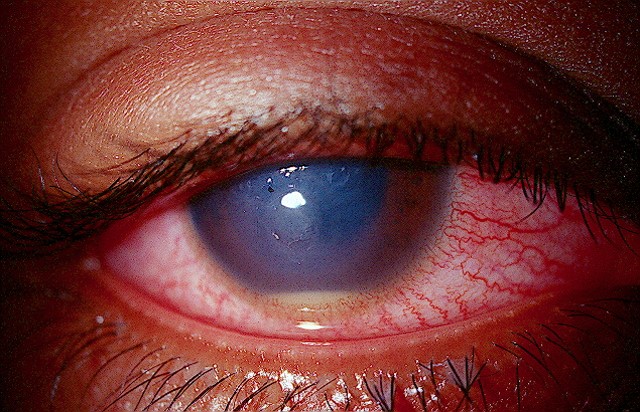 |
| The risk of endophthalmitis changes over the course of treatment in eyes undergoing intravitreal injections, increasing at a higher rate earlier on in the treatment course then decreasing with more injections. Photo: Joseph Sowka, OD. Click image to enlarge. |
Fortunately, nearly all patients who undergo years of intravitreal injections (IVI) don’t develop endophthalmitis. For the small number that do, however, it’s worthwhile to try to discern patterns in the complication’s incidence. In a new study, researchers sought to determine the rate of endophthalmitis in eyes undergoing IVIs of anti-VEGF based on cumulative number of injections per eye, and found that the per-injection risk of endophthalmitis increases at a higher rate earlier on in the treatment course.
The study included patients from a single center undergoing IVI of ranibizumab, aflibercept and/or bevacizumab. A total of 43,393 eyes received 652,421 anti-VEGF injections resulting in 231 endophthalmitis cases, of which 215 were included in this analysis.
The overall risk of endophthalmitis was found to be 0.035%, or one in 2,857 injections, with a higher cumulative risk of endophthalmitis with each additional injection seen earlier on in the treatment course and a lower cumulative risk observed with later injections.
A potential explanation is that there may be patient-related factors that make some patients more prone to developing endophthalmitis, causing them to present sooner after starting IVI or being more susceptible to infection. “For example, patients on immunosuppressive medications receiving IVI have been reported to be at increased risk for post-injection endophthalmitis,” the researchers noted in their article for the Ophthalmology journal.
They also noted it’s possible that the conjunctiva of eyes that develop endophthalmitis within the first few injections may have larger numbers of commensal bacteria or be colonized by bacteria of higher virulence.
“Furthermore, as was seen in brolucizumab-related intraocular inflammation (in another study), the possibility of noninfectious intraocular inflammation may be more likely during the first few IVIs, and if treated as presumed infectious endophthalmitis could also potentially account for the higher per-injection endophthalmitis risk earlier in the course of treatment,” the authors explained in their paper. “Overall, further investigation is warranted to better characterize these potential risk factors and the magnitude of their effects.
Additionally, final visual acuity was significantly worse in all eyes at subsequent visits after diagnosis, though some patients did recover all of their vision. “When looking at the differences between quartiles that developed endophthalmitis after a lower vs. higher number of injections, age, injection medication and pseudophakia were significantly different, while a history of smoking, diabetes, gender and final visual acuity outcomes were not,” the authors explained.
They suggested that future studies should be conducted that focus on exploring factors that may predispose certain eyes to developing earlier endophthalmitis following IVIs to understand the underlying reasons and better assess patient risk.
Israilevich RN, Mansour H, Patel SN, et al. Risk of endophthalmitis based on cumulative number of anti-vascular endothelial growth factor intravitreal injections. Ophthalmology. December 27, 2023. [Epub ahead of print.] |

